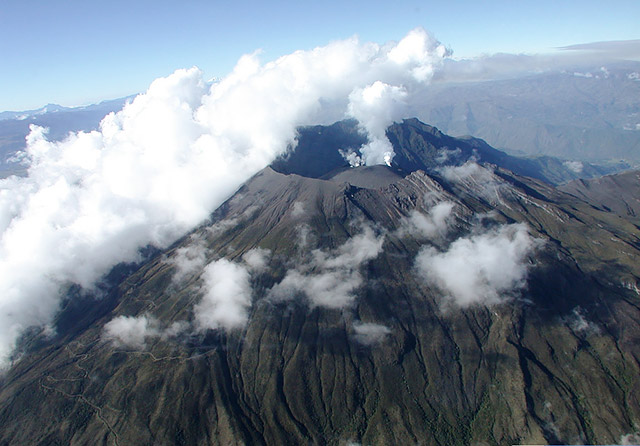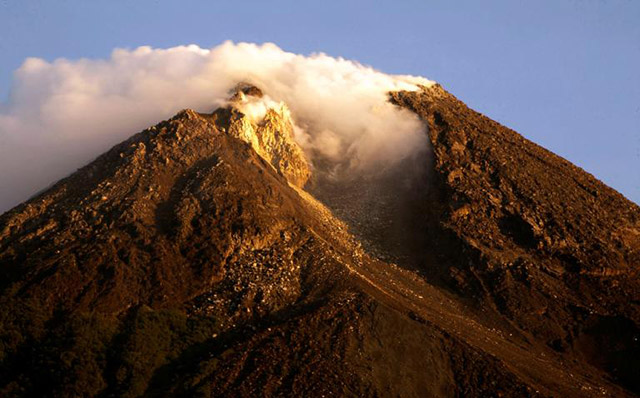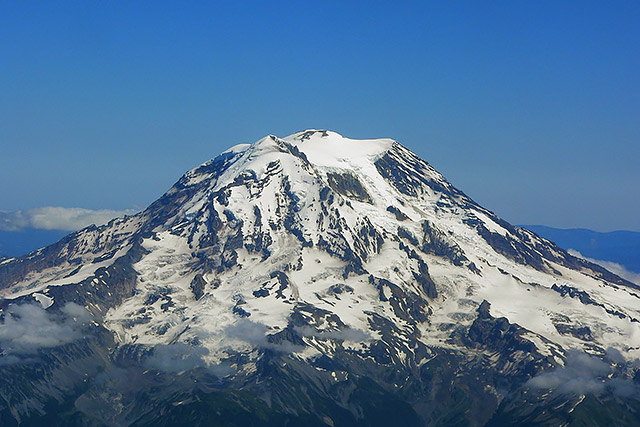On the morning of August 27th 1883 the small Indonesian island of Krakatoa virtually destroyed itself in a series of cataclysmic explosions the likes of which have never been witnessed in human history before or since. Not only was the explosion the loudest sound ever recorded, it released 4 times more energy than the most powerful nuclear weapon ever created, the Tsar Bomba. In fact the sound of Krakatoa going off was heard 4,830 km (3,000 miles) away and ruptured eardrums 64 km (40 miles) away.
It is estimated that anywhere between 35,000 and 120,000 people died as a result of the Krakatoa eruption. Most of these were as a result of tsunamis caused by the volcano, however around a thousand died in Ketimbang in Sumatra as a direct result of the eruption.
Today there are around 1,500 active volcanoes around the world, Anak Krakatau, “the Child of Krakatoa”. Most of these are located around the Pacific “Ring of Fire” including the biggest, Mauna Loa in Hawaii. However, there are plenty of notable exceptions including some of the most dangerous active volcanoes on earth.
Before heading to the list it is worth mentioning the scale by which volcanic eruptions are measured, the Volcanic explosivity index (VEI). This ranges from 0 to 8 with Krakatoa only scoring 6 or “colossal”. A score of 8 is described as “apocalyptic”. The good (or maybe bad) news is this hasn’t happened for nearly 25,000 years when Taupo in New Zealand blew.
10. Ulawun, Papua New Guinea

Ulawun is the classic cone shaped volcano with its smoking peak rising up out of the jungle. But it isn’t just jungle surrounding this active volcano, there are also several thousand people living within the vicinity.
Known locally as the “Father”, Ulawun is Papua New Guinea’s most active volcano and probably the most dangerous. One of the major risks posed by the volcano is slope failure. Given its height some have suggested it may be relatively unstable meaning an eruption could result in massive landslides which would devastate the surrounding area and result in the loss of many lives.
But it isn’t just the possibility of Ulawun erupting that is a reason to be wary of this volcano. It is estimated that Ulawun belches out almost 2% of all the world’s sulphur dioxide, a noxious pollutant.
9. Popocatepetl, Mexico

Not only is the snow-capped Popocatépetl the second highest mountain in Mexico, it is also a highly active volcano. What is most alarming about this enormous, smoke and fire belching stratovolcano is its proximity to the Mexican capital. Popocatépetl is only 70 km (40 mi) from Mexico City which is home to 18 million people. But it gets worse; the city of Puebla which is home to 2 million people is even closer. A major eruption here would be catastrophic with molten lava and mudslides flowing into the surrounding valleys and millions within the blast radius.
During the last 500 years there have been more than 15 major eruptions of Popocatépetl with the most recent in 1947. So there is plenty of previous form. Whilst things were relatively quiet activity seems to have picked up over recent years with rumblings in 2000 sparking a mass evacuation and any number of small eruptions since.
8. Mauna Loa, Hawaii

Mauna Loa is purported to be the largest active volcano on Earth. There is more lava bubbling away under this behemoth than any other volcano. Mauna Loa’s size is not entirely obvious from the 4,170 m (13,680 ft) peak but when you take into account that it rises up from the sea floor it is actually taller than Mount Everest.
As a shield volcano Mauna Loa is a bit of a gentle giant. Instead of exploding dramatically these volcanoes tend to spew out constant streams of magma forming shallow slopes. These lava flows are generally slow moving and possess little danger, except to property.
So why, I hear you ask, is Mauna Loa on this list of the World’s most dangerous volcanoes? Well, there is a Doomsday scenario. This huge volcano has grown rapidly of the millenia and there may be deep fault lines within the slopes of this sea mountain. A collapse and resulting massive landslide could cause a megatsunami. That’s right, a mega-tsunami! You may think this far-fetched but there is geological evidence of this sort of collapse 100,000 years ago causing a 1,000 ft (300 m) wave which piled into the island of Lāna`i. If the same were to happen at Mauna Loa, a tsunami would arrive in Honolulu within 30 minutes reaching as far as 16 miles (22 km) inland.
7. Yellowstone Caldera, USA

Now, the Yellowstone Supervolcano is a tricky one. It might be best placed at the top of this list or not on the list at all, nobody seems to know for sure. Given what it is and previous form the potential is pretty terrifying – think something along the scale of a nuclear war. Many of the largest volcanic eruptions ever took place in this region including one that was equivalent to a 250,000 megaton explosion – that’s over 1,000 times bigger than Krakatoa. During this eruption 1,200 cubic miles (5,000 km3) of rock was ejected, enough to fill Lake Michigan. What is more, so mush ash would be created that the entire USA would have been buried under a 10 feet (3 m) carpet making it uninhabitable, whilst the rest of the world would be starved of sunlight for months.
Fortunately, this all happened 27 million years ago.
Today the caldera measures around 40 miles (60 km) across, but it is what is underneath that gives cause for concern. It is estimated that there is a magma chamber measuring 50 miles (80 km) long and 12 miles (20 km) wide lurking beneath Yellowstone. That is huge, and is certainly on the supervolcano scale. However, whilst some media sources have claimed the next supereruption is now overdue scientists seem to dismiss this stating that such events are neither “regular or predictable”.
6. Sakurajima, Japan

Sakurajima in southern Japan is sometimes referred to as the “Vesuvius of the East” on account of its highly active nature. The similarities don’t end here either; located just a few miles away is the city of Kagoshima which is home to nearly 700,000 people. If there is a city anywhere that has prepared itself for the danger of an imminent volcanic eruption then it is Kagoshima. There are regular evacuation rehearsals and the city even has volcano shelters.
But this isn’t just for fun. Sakurajima is constantly throwing out columns of ash high into the atmosphere with thousands of minor explosions every year. So active is the volcano that it is one of only three volcanos to be placed on Level 3 (orange) alert. This means don’t get too close.
In a recent daytime eruption so much ash was ejected that it threw the Kagoshima city into darkness. However, this was nothing compared to an eruption in 1914 in which the former mountain island spewed out so much lava that it became part of the mainland.
Whilst on the subject of Japan it is worth pointing out that the iconic Mount Fuji is not just the country’s highest mountain, but an enormous volcano within 60 miles (100 km) of Tokyo…
5. Galeras, Colombia

If it is possible for a volcano to have a sense of irony Galeras in Colombia is such a volcano. In 1993 there was a conference on the world’s most dangerous volcanoes in the city of Pasto, at the foot of Galeras. Several of the scientists at the conference decided to take a closer look at the crater of Galeras at which point the volcano unexpectedly erupted killing six scientists and three tourists.
Galeras is the most active volcano in Colombia and has a erupted violently on several occasions in the past 500,000 years. Given that the city of Pasto, with its population of nearly half a million, is so close, it is little surprise that Galeras is categorised as a Decade Volcano.
Despite the devastating potential of Galeras it is another volcano in Colombia that has wrought the most destruction in recent times. On November 13, 1985, a minor eruption of Nevada del Ruiz caused a massive lahar (a landslide of ice and mud) to thunder through the surrounding river valleys destroying everything in their wake. This included the town of Armero with its population of 29,000. Despite the government having received warnings to evacuate the area this was not passed on. When the wall of debris slammed into the town it killed 20,000 people. Several thousand more were killed in the surrounding areas.
4. Mt. Merapi, Indonesia

About half of the 20 deadliest volcanic eruptions in history have happened in Indonesia including one which almost wiped out the human race. Krakatoa was one of these but barely made it into the top ten. So it is among this illustrious company that we have chosen Mount Merapi (“Mountain of Fire”) on the island of Java as the most potentially dangerous.
Merapi is certainly the most active volcano in Indonesia sitting on the Pacific Ring of Fire; belching smoke most days this volcano has erupted with deadly consequences at least twice in the last ten years. Historically there have been some huge eruptions at Merapi. One allegedly covered the whole of Java in ash whilst another has been cited as wiping out the Hindu Kingdom of Mataram.
The volcano has been erupting regularly for around the last 500 years with significant and violent eruptions every 10 to 15 years. This was the case in 2010 when despite 20,000 people being evacuated the death toll reached 353 and thousands of homes were destroyed. In 1930 things were much worse when more than ten villages were wiped out by lava flows killing at least 1,400 people.
It is these lava (pyroclastic) flows that make Merapi particularly dangerous flowing extremely rapidly and reaching out many miles from the peak. In the event of a really major eruption the city of Yogyakarta 17 miles (28 km) away would be at serious risk.
3. Mount Rainier, USA

Mount Rainer has much in common with Popocatépetl in Mexico. Both are massive, steep-sided stratovolcanoes and both are members of the exclusive “Decade Volcano” club, a list of 17 volcanoes that are considered particularly dangerous due to their proximity to centers of population and their history of destructive eruptions. This active volcano sits close to many small towns and cities including Seattle which is only 54 miles (87 km) away.
Rainer is the tallest mountain in Washington state with a prominence of 13,211 feet (4,027 m) – this is the height of the mountain alone. That’s bigger than K2, the world’s second tallest mountain.
Out of all the Decade volcanoes it is Mount Rainer that tops the list as the most potentially deadly. But it isn’t just the enormous size of Mount Rainer that makes it such a potential danger. The major threat from the volcano is the massive amount of ice trapped in glaciers on its slopes. It is hard to imagine how much ice we are talking about here but suffice to say it is enough to feed six substantial rivers.
If Mount Rainer erupted, in addition to lava it is likely these vast amounts of ice locked up the volcano would come cascading down the river valleys. These giant avalanches of ice and rock (known as lahars) would annihilate all in their path possibly reaching as far as Lake Washington or Puget Sound. If this happened tsunamis might be unleashed causing devastation to areas of Seattle.
The good news is no significant activity has been recorded in the last five years. In addition, warning systems and evacuation plans would hopefully avert major loss of life.
2. Mount Nyiragongo, Democratic Republic of Congo

Mount Nyiragongo has the classic cone shape associated with stratovolcanoes. At the top of its steep slopes is a 1.5 mile (2 km) wide crater which is filled with boiling lava. This lava lake varies in depth with time but has been estimated to reach around 2,000 (600 m) feet deep. In effect Nyiragongo is a massive cauldron of molten rock.
Someone else can do the math about how much lava that is but it doesn’t take a genius to figure out that it probably isn’t good to have a city of over a million people less than 10 miles (15 km) away. However, that’s exactly were the city of Goma is.
Unlike the slow moving lava flows of the shield volcanoes in Hawaii the lava at Nyiragongo moves fast. When in 1977 the crater walls gave way lava spewed out at a over 60 miles per hour (100 kph) annihilating several villages as it went. In a more recent eruption (2002) lava flows reeked a trail of destruction through the middle of Goma. A 600-300 ft (200-1000m) wide river of lava ran through the city destroying over 4,500 buildings in its path.
Despite the damage to property the evacuation of 400,000 people meant that relatively few lives were lost. 147 people were killed though, mostly from asphyxiation due to the release of suffocating carbon dioxide gas.
1. Mount Vesuvius and the Phlegraean Fields, Italy

The eruption of Mount Vesuvius in 79AD is one of the most well known in all of history. It embodies everything we fear in volcanoes and left a reminder for future generations. When Vesuvius erupted at around midday on August 24th it did so with the force of 100,000 atomic bombs. Molten rock and pumice ash were ejected from the mountain at the rate of 1.5 million tons per second. Much of this rained down on the nearby cities of Pompeii and Herculaneum killing thousands instantly and preserving them in suspended animation under a thick carpet of ash only to be discovered over a thousand years later.
Two thousand years on and Vesuvius is very much an active volcano with at least two significant eruptions. Perhaps the biggest difference now though is the 3 million people living in the vicinity of Mount Vesuvius, particularly in the densely populated city of Naples. This alone would be a good reason why Vesuvius tops the list of dangerous volcanoes, but no, it gets worse!
On the western edge of Naples are the Phlegraean Fields. Translating as “burning fields” this is an area of intense geothermal activity with various displays of bubbling mud, sulfurous belching and the likes. What the Phlegraean Fields are in fact is a vast caldera similar to the “Super Volcano” that lies beneath Yellowstone. Along with the similarities there is also the massive difference that this is underneath a major city.
It is estimated that the volcano here is capable of producing a VEI 7 eruption – that’s ten times greater than Krakatoa. Monitoring of the caldera is fairly intense, as it would have to be to make sure that more or less one million people in the immediate area were safely evacuated should the need arise.






Leave a Reply